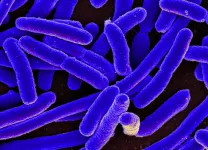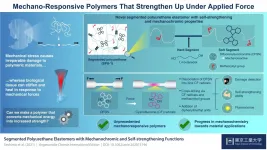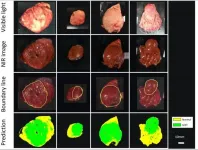(Press-News.org) The lockdowns and reduced societal activity related to the COVID-19 pandemic affected emissions of pollutants in ways that slightly warmed the planet for several months last year, according to new research led by the National Center for Atmospheric Research (NCAR).
The counterintuitive finding highlights the influence of airborne particles, or aerosols, that block incoming sunlight. When emissions of aerosols dropped last spring, more of the Sun's warmth reached the planet, especially in heavily industrialized nations, such as the United States and Russia, that normally pump high amounts of aerosols into the atmosphere.
"There was a big decline in emissions from the most polluting industries, and that had immediate, short-term effects on temperatures," said NCAR scientist Andrew Gettelman, the study's lead author. "Pollution cools the planet, so it makes sense that pollution reductions would warm the planet."
Temperatures over parts of Earth's land surface last spring were about 0.2-0.5 degrees Fahrenheit (0.1-0.3 degrees Celsius) warmer than would have been expected with prevailing weather conditions, the study found. The effect was most pronounced in regions that normally are associated with substantial emissions of aerosols, with the warming reaching about 0.7 degrees F (0.37 C) over much of the United States and Russia.
The new study highlights the complex and often conflicting influences of different types of emissions from power plants, motor vehicles, industrial facilities, and other sources. While aerosols tend to brighten clouds and reflect heat from the Sun back into space, carbon dioxide and other greenhouse gases have the opposite effect, trapping heat near the planet's surface and elevating temperatures.
Despite the short-term warming effects, Gettelman emphasized that the long-term impact of the pandemic may be to slightly slow climate change because of reduced emissions of carbon dioxide, which lingers in the atmosphere for decades and has a more gradual influence on climate. In contrast, aerosols - the focus of the new study - have a more immediate impact that fades away within a few years.
The study was published in Geophysical Research Letters. It was funded in part by the National Science Foundation, NCAR's sponsor. In addition to NCAR scientists, the study was co-authored by scientists at Oxford University, Imperial College, and the University of Leeds.
Teasing out the impacts
Although scientists have long been able to quantify the warming impacts of carbon dioxide, the climatic influence of various types of aerosols - including sulfates, nitrates, black carbon, and dust - has been more difficult to pin down. One of the major challenges for projecting the extent of future climate change is estimating the extent to which society will continue to emit aerosols in the future and the influence of the different types of aerosols on clouds and temperature.
To conduct the research, Gettelman and his co-authors used two of the world's leading climate models: the NCAR-based Community Earth System Model and a model known as ECHAM-HAMMOZ, which was developed by a consortium of European nations. They ran simulations on both models, adjusting emissions of aerosols and incorporating actual meteorological conditions in 2020, such as winds.
This approach enabled them to identify the impact of reduced emissions on temperature changes that were too small to tease out in actual observations, where they could be obscured by the variability in atmospheric conditions.
The results showed that the warming effect was strongest in the mid and upper latitudes of the Northern Hemisphere. The effect was mixed in the tropics and comparatively minor in much of the Southern Hemisphere, where aerosol emissions are not as pervasive.
Gettelman said the study will help scientists better understand the influence of various types of aerosols in different atmospheric conditions, helping to inform efforts to minimize climate change. Although the research illustrates how aerosols counter the warming influence of greenhouse gases, he emphasized that emitting more of them into the lower atmosphere is not a viable strategy for slowing climate change.
"Aerosol emissions have major health ramifications," he said. "Saying we should pollute is not practical."
INFORMATION:
About the article
Title: "Climate Impacts of COVID-19 Induced Emission Changes"
Authors: A. Gettelman, R. Lamboll, C. G. Bardeen, P. M. Forster, D. Watson-Parris
Journal: Geophysical Research Letters
This material is based upon work supported by the National Center for Atmospheric Research, a major facility sponsored by the National Science Foundation and managed by the University Corporation for Atmospheric Research. Any opinions, findings and conclusions or recommendations expressed in this material do not necessarily reflect the views of the National Science Foundation.
On the web: news.ucar.edu
On Twitter: @NCAR_Science
Yale researchers are developing a skin cancer treatment that involves injecting nanoparticles into the tumor, killing cancer cells with a two-pronged approach, as a potential alternative to surgery.
The results are published in the Proceedings of the National Academy of Sciences.
"For a lot of patients, treating skin cancer is much more involved than it would be if there was a way to effectively treat them with a simple procedure like an injection," said Dr. Michael Girardi, professor and vice chair of dermatology at Yale School of Medicine and senior author of the study. "That's always been a holy grail in dermatology -- to find a simpler way to treat skin cancers such as basal cell carcinoma and squamous cell carcinoma."
For the treatment, tumors are injected ...
A new study from scientists of the Max Planck Institute for Evolutionary Biology in Plön, Germany, and the Chinese Academy of Sciences in Beijing shows that the potential genetic burden of mutations arising from retrogenes is significantly greater than originally thought.
Genetic information is stored in DNA and transcribed as mRNA. The mRNA is usually translated into proteins. However, it has long been known that mRNA can also be reverse transcribed to DNA and integrated back into the genome. Such cases are referred to as retrogenes. In an article, a team from the Max Planck Institute for ...
When different groups of people come into contact, what's the key to motivating advantaged racial groups to join historically disadvantaged racial minority groups to strive for racial equality and social justice? It's a complex conundrum studied for years by social scientists like Linda Tropp, professor of social psychology at the University of Massachusetts Amherst.
Her latest research, published in the International Journal of Intercultural Relations, tested and supported Tropp and colleagues' proposition that having open communication about group differences is a crucial pathway.
While greater contact between racial groups is typically associated with less ...
New drivers between the ages of 15 and 25 account for nearly half of the more than one million road deaths that occur worldwide each year, according to the World Health Organization. Educational programs often use fear-based messaging and films of crash scenes to reduce risky driving behavior among young people. But does this "scary" approach work?
A new study published in the journal Risk Analysis suggests that fear-based messaging fails to reduce risky driving behavior, while fear-based Virtual Reality (VR) films depicting a violent collision may actually lead young drivers to take more chances behind the wheel.
A team of psychologists led by University of Antwerp researcher Clara Alida Cutello, PhD, conducted a study of 146 students ...
Are Gut Microbes the Key to Unlocking Anxiety
A mouse study suggests the genetic contribution to anxiety is partially mediated by the gut microbiome
By Greta Lorge
The prevalence of anxiety disorders, already the most common mental illness in many countries, including the U.S., has surged during the novel coronavirus pandemic. A study led by researchers in Berkeley Lab's Biosciences Area provides evidence that taking care of our gut microbiome may help mitigate some of that anxiety.
The team used a genetically heterogeneous lineage of mice known as the Collaborative Cross (CC) to probe connections among genes, gut microbiome ...
A fascinating and crucial ability of biological tissue, such as muscle, is self-healing and self-strengthening in response to damage caused by external forces. Most human-made polymers, on the other hand, break irreversibly under enough mechanical stress, which makes them less useful for certain critical applications like manufacturing artificial organs. But what if we could design polymers that reacted chemically to mechanical stimuli and used this energy to enhance their properties?
This goal, which has proven to be a big challenge, is under the spotlight in the field of mechanochemistry. In a recent study published in Angewandte Chemie ...
Tumors can be damaging to surrounding blood vessels and tissues even if they're benign. If they're malignant, they're aggressive and sneaky, and often irrevocably damaging. In the latter case, early detection is key to treatment and recovery. But such detection can sometimes require advanced imaging technology, beyond what is available commercially today.
For instance, some tumors occur deep inside organs and tissues, covered by a mucosal layer, which makes it difficult for scientists to directly observe them with standard methods like endoscopy (which inserts a small camera into a patient's body via a thin ...
Telehealth use has surged during the pandemic at clinics that serve lower-income Americans, which allowed the clinics to maintain access to care at a time when many other health care organizations saw significant declines in utilization, according to a new RAND Corporation study.
However, most of the telehealth appointments have been audio-only visits, which may pose challenges in the future if payers consider dropping reimbursement for such services.
Studying more than 500 clinic locations across California, researchers found that while overall visit volume remained stable during the pandemic, about half of primary care medical visits from March to August 2020 ...
Nanoscience - Blowing the whistle on COVID-19
Collaborators at Oak Ridge National Laboratory and the University of Tennessee Health Science Center are developing a breath-sampling whistle that could make COVID-19 screening easy to do at home.
The technology incorporates a unique hydrogel material to capture aerosols from exhaled breath and preserve the samples, which could either be sent to a lab for analysis or, for a fully at-home approach, transferred to an accompanying test kit that could detect the SARS-CoV-2 virus that causes COVID-19.
"Our motivation ...
Topological insulators are one of the most puzzling quantum materials - a class of materials whose electrons cooperate in surprising ways to produce unexpected properties. The edges of a TI are electron superhighways where electrons flow with no loss, ignoring any impurities or other obstacles in their path, while the bulk of the material blocks electron flow.
Scientists have studied these puzzling materials since their discovery just over a decade ago with an eye to harnessing them for things like quantum computing and information processing.
Now researchers at the Department ...




